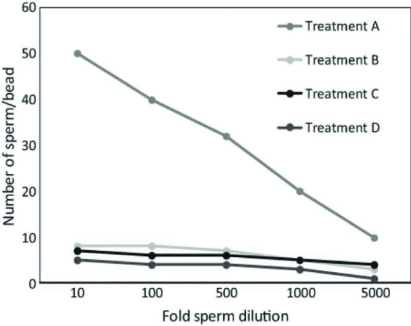Multiple Choice
Use the following information to answer the question.
In an investigation into sperm-oocyte binding, researchers isolated the egg receptor protein, ERB1, from the sea urchin Strongylocentrotus purpuratus. ERB1 binds to the sperm acrosomal protein, bindin, during fertilization. The researchers coupled the ERB1 receptor from S. purpuratus to plastic microbeads and then mixed the ERB1-coupled beads with sperm from S. purpuratus or from the related species, S. franciscanus. A summary of the treatment mixtures and a graph of the results are shown.
Treatments:
A: S. purpuratus sperm mixed with S. purpuratus ERB1-coupled beads
B: S. purpuratus sperm mixed with beads with no coupled ERB1 protein
C: S. franciscanus sperm mixed with S. purpuratus ERB1 beads
D: S. franciscanus sperm mixed with beads with no coupled ERB1 protein 
Which of the following is a broader implication from the observations of the experiment?
A) In sea urchins, fertilization of eggs by sperm is dependent upon species-specific protein interactions.
B) Only some species of sea urchins use receptor proteins on their eggs to bind sperm.
C) Protein-coated plastic beads should not be used to test sperm binding to eggs.
D) S. franciscanus is probably not a sea urchin, but must be some other type of organism.
Correct Answer:

Verified
Correct Answer:
Verified
Q58: Which of the following is a primary
Q59: Which of the following is most likely
Q60: Which of the following correctly describes gastrulation
Q61: The cortical reaction of sea urchin eggs
Q62: Cell migration occurs extensively as part of
Q63: In mammalian eggs, the receptors for sperm
Q64: Which of the following is common to
Q65: Which of the following is an adult
Q67: Which of the following is common to
Q68: Identical twins are possible in humans because